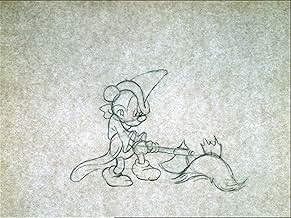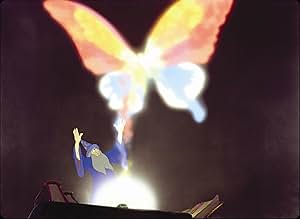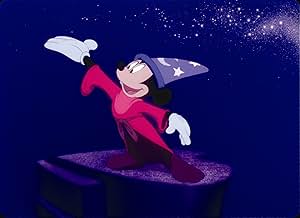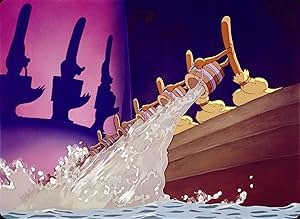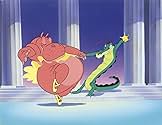Fantasia
- 1940
- Tous publics
- 2h 4min
Une suite de huit dessins animés illustrant de grands morceaux de musique classique.Une suite de huit dessins animés illustrant de grands morceaux de musique classique.Une suite de huit dessins animés illustrant de grands morceaux de musique classique.
- Récompenses
- 9 victoires et 1 nomination au total
Corey Burton
- Narrator: Deems Taylor overdubs (2000 restoration)
- (voix)
- (non crédité)
Walt Disney
- Mickey Mouse (segment 'The Sorcerer's Apprentice')
- (voix)
- (non crédité)
Hugh Douglas
- Narrator (1982 version)
- (voix)
- (non crédité)
James MacDonald
- Percussionist
- (non crédité)
Tim Matheson
- Narrator (1985 version)
- (voix)
- (non crédité)
Julietta Novis
- Soloist (segment 'Ave Maria')
- (voix (chant))
- (non crédité)
Paul J. Smith
- Violinist
- (non crédité)
Avis à la une
2017 is a year of technical marvel. Looking at movies of today, we see massive, stunning works of animation. We can now achieve computer generated images that look nearly indistinguishable from reality, and at the forefront of movie making today is Disney. Through Marvel, Disney creates multiple action packed superhero blockbusters a year. Star Wars, after it's 2015 revival, has new movies being released annually. Pixar, after creating several successful franchises, is now resting on its laurels, creating sequels like Finding Dory, Toy Story 4, Cars 3 and Incredibles 2. Even Disney's in house animation team is finding success, bringing back the Disney princess formula with movies like Frozen and Moana. However, amidst all this success, we have lost the truly human touch. Fantasia perfectly captures all that was lost in today's Disney movies. The movie has a very personal and human feel to every aspect of it. The orchestra, a very tangible presence in the movie, feels alive. They laugh, play their own little tunes during the intermission, but most importantly, they make mistakes. The animation is the same way, It's very rough at times and sometimes lacking, with some animations being reused, however every shot is filled with passion. You can tell that people worked on this, people with ambition, though they were not perfect. In modern movies, this beautiful animation that looks so real lacks the touch of individualism that Fantasia has in spades. The scene of the Sorcerer's apprentice dancing around the broom is burned into our collective memory for a reason. In all its flaws, its rough edges, it feels real to us. We can see all the raw effort and energy that the animator's put into each of Mickey's footsteps and that resonates with us. Fantasia speaks to the viewer not because it's perfect, but because it's flawed.
This unusual and very creative classic of animation combines a very interesting idea with quite a bit of imagination, plus visual effects that still hold up quite well. All but a couple of the sequences are quite enjoyable, and some especially so. Even the segments that don't work as well are usually at least interesting, since you can at least appreciate what they were trying to accomplish.
You don't really have to be all that familiar with the specific pieces of music for it to be worthwhile, since in several cases they chose to match the music with material that is rather different in nature from any original context that it may have had. And in any case, the animated sequences are intended to provide the context, in terms of the movie.
No doubt, everyone will have his or her own favorite segments, based on the music itself and on the choice of accompanying visual material. The "Sorcerer's Apprentice" sequence, with Mickey Mouse, is certainly one of the most memorable. The adaptation of "The Rite of Spring" is quite imaginative in using an entirely different setting for the music. "Night on Bald Mountain" has striking and sometimes bizarre visuals.
Many of the classic Disney features still hold up well as family entertainment, but "Fantasia" is unique for its combination of imaginative concept and visual creativity. Not every minute of it works, but that's the price of being willing to experiment. It's an enjoyable and satisfying feature that well deserves to be remembered.
You don't really have to be all that familiar with the specific pieces of music for it to be worthwhile, since in several cases they chose to match the music with material that is rather different in nature from any original context that it may have had. And in any case, the animated sequences are intended to provide the context, in terms of the movie.
No doubt, everyone will have his or her own favorite segments, based on the music itself and on the choice of accompanying visual material. The "Sorcerer's Apprentice" sequence, with Mickey Mouse, is certainly one of the most memorable. The adaptation of "The Rite of Spring" is quite imaginative in using an entirely different setting for the music. "Night on Bald Mountain" has striking and sometimes bizarre visuals.
Many of the classic Disney features still hold up well as family entertainment, but "Fantasia" is unique for its combination of imaginative concept and visual creativity. Not every minute of it works, but that's the price of being willing to experiment. It's an enjoyable and satisfying feature that well deserves to be remembered.
10Spleen
There cannot be one verdict on "Fantasia". There must be eight: one for each of the seven segments, and an eighth for the film as a whole - for, varied though the seven segments are, they undeniably belong together. And, alas, space does not permit me to lay out all eight verdicts. I shall have to confine myself to details representative of the whole. At any rate, I shall try.
We learn the modus operandi of "Fantasia", the linking theme, in the second segment - an abridged version of Tchaikovsky's "Nutcracker" suite. (Missing are the overture and the march.) Tchaikovsky's ballet involves anthropomorphising inanimate things, plus the odd tiny animal. So does Disney's "Nutcracker". But Disney has thrown out the particular details. The Chinese Dance is danced by mushrooms (who look, but are not, Chinese); the Arabian Dance by "Arabian" goldfish; the Russian dance by "Russian" thistles and orchids. Sometimes it goes further: "Waltz of the Flowers" shows two entire changes of seasons, with leaves, fairies, seed pods, seeds, snowflakes - everything but flowers. But in ignoring the letter of the instructions Disney is perfectly true to the spirit. Indeed he is more true to the spirit than the original ballet - for, let's face it: stage ballet is a degenerate and over-formalised art, which makes some of the world's most exciting music dull as wallpaper. Disney's amazing images express Tchaikovsky's sense of motion more than earthbound dancers ever could. This, one feels, is the kind of thing ballet music was TRULY designed for. The same goes to a lesser extent for the other two pieces of ballet music on the program.
This basic device - ignoring explicit instructions, but remaining true to the spirit - is carried through into every segment. (Some segments are better than others, but none can be called a failure.) Dukas's "The Sorcerer's Apprentice" has been turned into a Mickey Mouse cartoon - but it's the best Mickey Mouse cartoon ever made; and we realise that the story of the Sorcerer's Apprentice is really the archetype that all of the best Mickey Mouse cartoons had been reaching towards, all along. The Pastoral Symphony adheres to Beethoven's program but moves everything from the woods of Central Europe to a dreamland from classical mythology. (The second movement - the section with the courting centaurs - is a failure. For once the spirit as well as the letter of Beethoven is ignored. Unfortunately some critics cannot see beyond this movement to the superb interpretations that flank it on either side.)
I doubt that so much genuine creative work has gone into a film, before or since - even if you don't count the contributions made by the composers. What's my favourite film? I really don't know. But if you tell me that I must sit in a large dark cinema for two hours; and ask me what I would like to occupy my eyes and ears over those two hours, I would answer, without hesitation, Fantasia.
We learn the modus operandi of "Fantasia", the linking theme, in the second segment - an abridged version of Tchaikovsky's "Nutcracker" suite. (Missing are the overture and the march.) Tchaikovsky's ballet involves anthropomorphising inanimate things, plus the odd tiny animal. So does Disney's "Nutcracker". But Disney has thrown out the particular details. The Chinese Dance is danced by mushrooms (who look, but are not, Chinese); the Arabian Dance by "Arabian" goldfish; the Russian dance by "Russian" thistles and orchids. Sometimes it goes further: "Waltz of the Flowers" shows two entire changes of seasons, with leaves, fairies, seed pods, seeds, snowflakes - everything but flowers. But in ignoring the letter of the instructions Disney is perfectly true to the spirit. Indeed he is more true to the spirit than the original ballet - for, let's face it: stage ballet is a degenerate and over-formalised art, which makes some of the world's most exciting music dull as wallpaper. Disney's amazing images express Tchaikovsky's sense of motion more than earthbound dancers ever could. This, one feels, is the kind of thing ballet music was TRULY designed for. The same goes to a lesser extent for the other two pieces of ballet music on the program.
This basic device - ignoring explicit instructions, but remaining true to the spirit - is carried through into every segment. (Some segments are better than others, but none can be called a failure.) Dukas's "The Sorcerer's Apprentice" has been turned into a Mickey Mouse cartoon - but it's the best Mickey Mouse cartoon ever made; and we realise that the story of the Sorcerer's Apprentice is really the archetype that all of the best Mickey Mouse cartoons had been reaching towards, all along. The Pastoral Symphony adheres to Beethoven's program but moves everything from the woods of Central Europe to a dreamland from classical mythology. (The second movement - the section with the courting centaurs - is a failure. For once the spirit as well as the letter of Beethoven is ignored. Unfortunately some critics cannot see beyond this movement to the superb interpretations that flank it on either side.)
I doubt that so much genuine creative work has gone into a film, before or since - even if you don't count the contributions made by the composers. What's my favourite film? I really don't know. But if you tell me that I must sit in a large dark cinema for two hours; and ask me what I would like to occupy my eyes and ears over those two hours, I would answer, without hesitation, Fantasia.
This without a doubt the greatest animated film in history. While highly acclaimed and well-known today, it was not terribly popular when it was first released. The idea of "Fantasia" is to take great pieces of music and draw animated sequences that match them. In doing so, it reverses the purpose of a movie's score; the movie serves and matches the music, not the other way around. This set up also means that there is no typical formula plot that is present in the vast majority of movies. In the first piece, the animation is vague and abstract, but in later ones it is of definite actions, objects, and stories. The two most famous(and my favorite) parts are probably "The Sorcerer's Apprentice" and "Rite of Spring". "Fantasia" is not only the best animated film ever made, but one of the greatest films period.
I first remember hearing about this movie when I was very little, and ever since I first watched it on VHS, it has always been one of the many examples of my favorite movies of all time. This is so unique, because unlike a typical Disney movie, in this movie we do not hear any dialog from the characters, and all of the music is instrumental (except for "Ave Maria" at the end). The film is divided into eight sequences, each of them being introduced by a guy named Deems Taylor, who was a very well-known music critique.
The eight segments are as follows:
1.) "Tocatta & Fugue in D-minor" composed by Johanne Sebastian Bach. This segment consists of shots of the Philadelphia Orchestra and their conductor Leopold Stokowski with a lot of cool shadow and color effects during the first three minutes, then we see a lot of shapes and random objects that Taylor would suggest to us might pop into our brains when listening to the music.
2.) "The Nutcracker Suite" composed by Tchaikovsky. In this part of the movie, we listen to excerpts of the famous ballet suite, and we see various fairies, flowers, fish and other nature-related creatures.
3.) Everyone's favorite "The Sorcerer's Apprentice" starring Sorcerer Mickey and Yen Sid (the sorcerer whose name is "Disney" spelled backwards). This is also the only segment to be seen again in this film's sequel, "Fantasia/2000" 60 years later, and in it the apprentice brings to life a magical broomstick to try to fill a cauldron with water, and the spell goes wrong so the apprentice gets reprimanded. This is then followed by Mickey greeting conductor Stokowski.
4.) "Rite of Spring" composed by Igor Stravinsky. This segment takes place billions and billions of years ago with the coming of the dinosaurs, where we see the creation of Earth in the beginning of time, and are later introduced to all of the different dinosaurs including the tyrannosaurus rex, which become extinct in the end of the segment.
5.) "Intermission/Meet the Soundtrack". At this point in the film, Deems Taylor introduces this string thingamajigger called the "Soundtrack" that he asks to make a lot of sounds resembling various instrument sounds.
6.) "Pastoral Symphony No. 6" composed by Beethoven. This segment is about a day in the countryside, and in it we see a lot of Greek mythology creatures like unicorns, satyrs, centaurs and centaurettes, cupids, Bacchus, Zeus, Iris, Apollo and Diana.
7.) "Dance of the Hours". This is where we see dancing ostriches, alligators, elephants and hippos. Each part of the piece suggests different hours of the day, and it all ends with a triumphant finale where the dancing hippo takes center stage.
8.) A combination of two pieces that are utterly different in mood and tone. They are "Night on Bald Mountain" in which a bat villain named Chernabog has Satan's evil spirits dance furiously until the coming of the sacred dawn, and then Franz Schubert's "Ave Maria" which is the one and only part of the whole film in which we hear lyrics sung, and then the movie ends.
I simply must say that not only is this film one of my all time favorite animated masterpieces, but it is also an example of a big highlight of the 1940's in cinematic history, all because of the ways it is so unique and special. In addition to this masterpiece, I also think "The Wizard of Oz", "Gone with the Wind", "Citizen Kane" and "Casablanca" are main icons of cinematic successes. I definitely think this should have been the first animated movie to be nominated for the Best Picture Academy Award instead of "Beauty and the Beast".
The eight segments are as follows:
1.) "Tocatta & Fugue in D-minor" composed by Johanne Sebastian Bach. This segment consists of shots of the Philadelphia Orchestra and their conductor Leopold Stokowski with a lot of cool shadow and color effects during the first three minutes, then we see a lot of shapes and random objects that Taylor would suggest to us might pop into our brains when listening to the music.
2.) "The Nutcracker Suite" composed by Tchaikovsky. In this part of the movie, we listen to excerpts of the famous ballet suite, and we see various fairies, flowers, fish and other nature-related creatures.
3.) Everyone's favorite "The Sorcerer's Apprentice" starring Sorcerer Mickey and Yen Sid (the sorcerer whose name is "Disney" spelled backwards). This is also the only segment to be seen again in this film's sequel, "Fantasia/2000" 60 years later, and in it the apprentice brings to life a magical broomstick to try to fill a cauldron with water, and the spell goes wrong so the apprentice gets reprimanded. This is then followed by Mickey greeting conductor Stokowski.
4.) "Rite of Spring" composed by Igor Stravinsky. This segment takes place billions and billions of years ago with the coming of the dinosaurs, where we see the creation of Earth in the beginning of time, and are later introduced to all of the different dinosaurs including the tyrannosaurus rex, which become extinct in the end of the segment.
5.) "Intermission/Meet the Soundtrack". At this point in the film, Deems Taylor introduces this string thingamajigger called the "Soundtrack" that he asks to make a lot of sounds resembling various instrument sounds.
6.) "Pastoral Symphony No. 6" composed by Beethoven. This segment is about a day in the countryside, and in it we see a lot of Greek mythology creatures like unicorns, satyrs, centaurs and centaurettes, cupids, Bacchus, Zeus, Iris, Apollo and Diana.
7.) "Dance of the Hours". This is where we see dancing ostriches, alligators, elephants and hippos. Each part of the piece suggests different hours of the day, and it all ends with a triumphant finale where the dancing hippo takes center stage.
8.) A combination of two pieces that are utterly different in mood and tone. They are "Night on Bald Mountain" in which a bat villain named Chernabog has Satan's evil spirits dance furiously until the coming of the sacred dawn, and then Franz Schubert's "Ave Maria" which is the one and only part of the whole film in which we hear lyrics sung, and then the movie ends.
I simply must say that not only is this film one of my all time favorite animated masterpieces, but it is also an example of a big highlight of the 1940's in cinematic history, all because of the ways it is so unique and special. In addition to this masterpiece, I also think "The Wizard of Oz", "Gone with the Wind", "Citizen Kane" and "Casablanca" are main icons of cinematic successes. I definitely think this should have been the first animated movie to be nominated for the Best Picture Academy Award instead of "Beauty and the Beast".
Le saviez-vous
- AnecdotesDuring production, the animators were given no instructions for coloring. Walt Disney instructed them to use any colors they wanted, which was a first.
- GaffesWhen introducing the "Pastoral" sequence, Deems Taylor mixes Greek and Roman names of deities: Bacchus, Vulcan and Diana are Roman; Zeus, Iris and Morpheus are Greek. Apollo is the only one whose Greek and Roman equivalents have the same name.
- Citations
Mickey Mouse: [Pulling on Stokowski's coat] Mr. Stokowski! Mr. Stokowski!
[Mickey whistles to get Stokowski's attention]
Mickey Mouse: My congratulations, sir!
Leopold Stokowski: [shaking hands with Mickey] Congratulations to you, Mickey!
Mickey Mouse: Gee, thanks! Hehe! Well, so long! I'll be seeing ya!
Leopold Stokowski: Goodbye!
- Crédits fousThere are no closing credits of any kind. Not even the words "THE END" appear on the screen.
- Versions alternativesBefore the 1990 re-release, the film was shown with no credits other than the title and the RKO logo. Leopold Stokowski received a written credit only on the posters advertising the film. In the film's original roadshow release, not even the title was shown at the beginning of the film - that was saved for the intermission break.
- ConnexionsEdited into Un monde est né (1955)
- Bandes originalesToccata and Fugue in D Minor, BWV 565
Composed by Johann Sebastian Bach
Orchestrated by Leopold Stokowski (uncredited)
Played by The Philadelphia Orchestra
Conducted by Leopold Stokowski
Meilleurs choix
Connectez-vous pour évaluer et suivre la liste de favoris afin de recevoir des recommandations personnalisées
Détails
Box-office
- Budget
- 2 280 000 $US (estimé)
- Montant brut aux États-Unis et au Canada
- 76 408 097 $US
- Week-end de sortie aux États-Unis et au Canada
- 980 798 $US
- 10 févr. 1985
- Montant brut mondial
- 76 414 517 $US
- Durée
- 2h 4min(124 min)
- Couleur
- Mixage
- Rapport de forme
- 1.37 : 1
Contribuer à cette page
Suggérer une modification ou ajouter du contenu manquant





